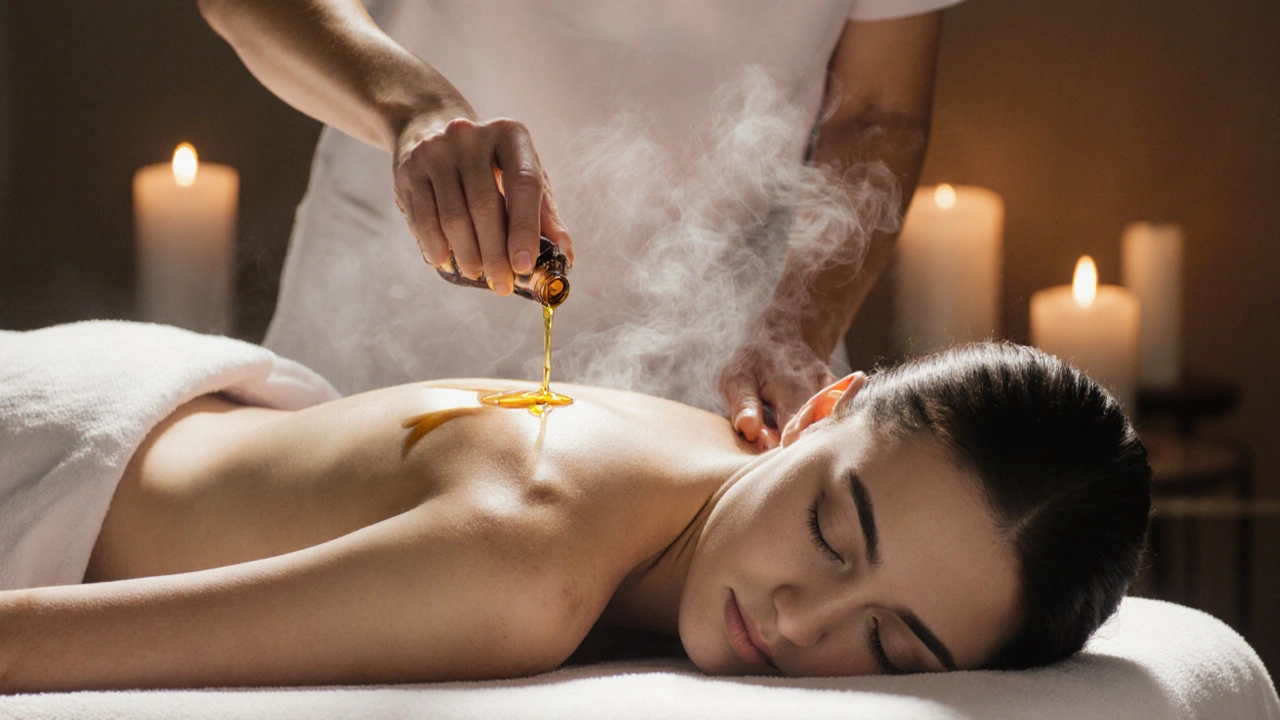The Future of Massage Therapy: What Aspiring Therapists Should Know

Ever thought about stepping into the world of massage therapy? It’s a field buzzing with energy and opportunities. With more folks looking for ways to unwind and stay healthy, the demand for skilled massage therapists is skyrocketing. But before you roll up your sleeves and dive in, let’s chat about what’s changing in the industry, and what you need to know.
First up, why is massage therapy becoming so popular? People are waking up to the health benefits of regular massages—from reducing stress to boosting overall wellness. Plus, new techniques and technology are making the experience even better. You might not need a crystal ball to see that learning these new tricks could put you a step ahead.
Then there’s the question of skills. Not just about knowing the moves—but also about understanding clients' needs. Whether it’s mastering the perfect pressure or learning to listen, these skills can set you apart. It’s not just about hands-on work; it’s about creating an experience that leaves your clients coming back for more. So if you’re ready to explore what the future holds, let’s dig into the details of becoming a top-notch massage therapist.
- Why Massage Therapy is Thriving
- Emerging Trends and Techniques
- Essential Skills for Future Therapists
- Navigating Courses and Certifications
- Building a Successful Practice
Why Massage Therapy is Thriving
You might wonder why massage therapy is booming right now. It's not just a trend—it's a shift in how we look at health and wellness. More and more, people are seeking natural and holistic ways to feel better. Instead of popping pills, many are turning to therapeutic touch, which shows how our views on health are transforming.
The numbers speak for themselves too. As of 2025, the global wellness economy is sitting at around $4.5 trillion, and massage therapy is a solid chunk of that pie. Folks are spending not just on relaxing spa days but on regular treatments that fit into their routines, kind of like going to the gym.
Massage therapy isn’t just about relaxing anymore. There's solid evidence showing it helps with things like chronic pain, anxiety, and even boosting your immune system. So, it’s not surprising that doctors and health professionals are starting to recommend it as part of treatment plans. And that’s huge because it means more people are considering it as a real option.
Plus, the variety of massages out there is expanding. You've got everything from traditional Swedish to more niche stuff like hot stone or prenatal massages. People love having choices, and this wide range of options means there’s likely a type of massage for everyone.
Another reason massage therapy is thriving? Technology. Yep, even massage therapists are getting techy. There are online booking systems, apps for client management, and even virtual consultations. It’s a win-win: therapists have it easier, and clients get more convenient access to services.
Massage therapy is more than a fad. As long as there's stress—and let’s face it, that's not going anywhere—the demand for skilled, caring therapists will keep growing. So, if you're keen on a career that’s all about helping others while staying in demand, this is a pretty smart path to consider.
Emerging Trends and Techniques
Ready to get up to speed with what's new and exciting in the world of massage therapy? There’s a whole bunch of stuff happening that’s shaking things up. Keeping tabs on these emerging trends can really help you stand out in the crowd of aspiring therapists.
First off, technology is starting to play a big role. You might see things like massage apps offering tailored routines for specific body parts, which means you can customize the experience for your clients down to the T. Then there are smart massage chairs and beds that give clients a preview of what you’re capable of when you step in with your personal touch.
Another trend is the integration of personalized care plans. People want a massage experience that’s as unique as they are. By spending some time learning about the client's lifestyle and stressors, therapists now create individualized treatments that resonate on a deeper level.
Speaking of personalization, let’s not forget about holistic therapies. This is where massage therapy teams up with aromatherapy, acupressure, or even meditation. Mixing these elements can offer a one-of-a-kind experience that can improve both physical wellness and mental clarity. Imagine combining a gentle massage with essentials oils recommended specifically for stress relief or energy boosting.
Then there’s the huge wave of therapeutic massages that deal with specific health concerns like chronic pain or sports injuries. More therapists are getting additional training in fields like physiotherapy and psychology, allowing them to provide more comprehensive care.
Here’s a quick glance at some popular techniques on the rise:
- Trigger Point Therapy: Targets specific tension spots, providing relief from muscle knots.
- Myofascial Release: Focuses on releasing tightness and pain caused by the connective tissues.
- CBD-Infused Massage: Uses CBD oils to potentially enhance relaxation and pain relief.
And hey, numbers don't lie. A recent survey showed that around 68% of spa clients are keen on trying innovative therapy sessions, which signals huge potential for those willing to explore these fronts. The key here is to keep learning and take courses that help you stay ahead in massage therapy. You never know, these skills might just be the reason clients keep coming back!

Essential Skills for Future Therapists
So, you’re thinking of becoming a massage therapist? Great choice! But let’s get real—it’s not all about kneading muscles like dough. If you want to shine in the massage world, there are a few key skills you need to have up your sleeve.
Communication is right at the top. I know, I know, we talk about it all the time, but being a good listener and fully understanding your clients’ needs is a game changer. Can you imagine giving a client with a stress-induced headache a deep tissue massage instead of a calming head rub? Not ideal.
Then there’s empathy. This isn’t just about feeling what your client's going through; it's about creating a safe, welcoming environment. People come to you to feel better physically and emotionally. A sincere, caring approach goes a long way.
Being skilled in technology might sound odd for massage therapy, but hear me out. From online booking systems to apps that help track customer preferences, tech is becoming a big part of the business. Being tech-savvy helps streamline operations and enriches the client experience.
Another important skill? Knowing your anatomy. Understanding how muscles connect and function ensures you’re targeting the right areas for relief. This solid foundation builds your confidence and effectiveness as a therapist.
“The key to a successful career in massage therapy is a combination of skill, empathy, and continuous learning,” shares Megan Blake, a renowned therapist and instructor.
Don’t forget about physical stamina. Massages may look relaxing, but they can be demanding on your body. Building your strength and endurance is crucial to delivering great massages day in and day out.
- Stay Updated: Regularly take workshops and courses to keep up with the latest techniques and trends.
- Networking: Connect with other therapists to share experiences and learn.
And finally, flexibility—not just the physical kind. Each client is unique, so adapting to different needs and delivering personalized services makes a huge difference. Master these skills, and you'll be well on your way to becoming a sought-after massage therapist.
Navigating Courses and Certifications
So, you’re all set to dive into the world of massage therapy, but where do you start? Getting the right education and credentials is crucial. Trust me, it's easier than it sounds once you know what to look for.
First off, make sure any training program is accredited. Look for programs approved by the Massage Therapy Bodywork Licensing Exam (MBLEx) or the National Certification Board for Therapeutic Massage and Bodywork (NCBTMB). These guys ensure that your course meets industry standards.
What will you learn? Expect to cover a range of topics, such as anatomy, physiology, and different massage techniques. Hands-on practice is a big part of these courses too. You’ll want to find a program that offers plenty of real-world experience so you can feel confident when you start working with clients.
Another thing to consider is online vs. in-person training. Online courses offer flexibility but come with limitations—like less hands-on experience—which is pretty vital in this field. If you're more into face-to-face interaction and practice, go for in-person classes.
Ready to enroll? Here’s a quick cheat sheet on what your journey might look like:
- Select a school: Find a program that matches your career goals. Some focus more on holistic approaches, while others are heavy on medical massage.
- Complete the coursework: Dive deep into subjects like Swedish massage, ethics, and kinesiology. Hands-on training is a must!
- Pass certification exams: These are the final hurdles. Acing these exams is crucial for becoming a licensed therapist.
- Get your license: Once certified, apply for a state license where you plan to work. Each state has its requirements, so double-check!
Still wondering about costs? On average, tuition can range between $5,000 to $15,000 depending on the program and location. Sure, it's an investment, but think of it as the ticket to stepping into a rewarding career.
Navigating courses and certifications might seem daunting at first, but once you get started, you'll see it's all part of the exciting journey of becoming a top-tier massage therapist. Happy learning!

Building a Successful Practice
So you're ready to set up a massage therapy practice, huh? Well, buckle up, because creating a thriving business is as much about strategy as it is about your amazing skills. Let’s break it down into bite-sized steps.
First things first: you need to decide how you want to operate. Are you thinking of a cozy home studio, or maybe renting a space in a wellness center? Each option has its perks, and it ultimately depends on your personal and financial situation. Just remember, the environment needs to be welcoming and professional; think calming music and soothing scents.
Marketing might sound like a whole different ballgame, but it’s crucial. These days, being visible online isn’t just a good idea—it’s a must. Start by building a simple website showcasing your services, prices, and a little about you. Don’t shy away from social media either. Platforms like Instagram and Facebook can help you reach local clients who are all about the massage therapy future.
Networking is another biggie. Get involved with local wellness events or join massage therapy forums online. Meeting other therapists could lead to referrals, partnerships, or just more knowledge about what’s trending in the massage techniques world. You never know when those connections will pay off.
Now, let’s crunch some numbers. Setting your pricing can feel like a balancing act. You want to attract clients with competitive rates but also make sure you're covering expenses and earning a decent living. Checking out what other therapists in your area charge can give you a realistic starting point.
Consider offering special promotions or packages to draw in new clients. Things like a discount for first-time visitors or a loyalty program can encourage repeat business. The key is to provide value while also earning a sustainable income.
| Expense | Cost Range |
|---|---|
| Studio Rent | $500 - $1500/month |
| Website and Marketing | $100 - $300/month |
| Initial Equipment Set-Up | $2000 - $5000 one-time |
Finally, staying on top of trends in therapy trends ensures you’re offering what clients want. Continuing education is key—maybe it's time to hit up a workshop or two, learning new therapist skills can keep your practice booming.
Remember, building your practice is a journey. Stay flexible, keep learning, and most importantly, provide a top-notch experience for your clients. They're your best advertisement, after all!



